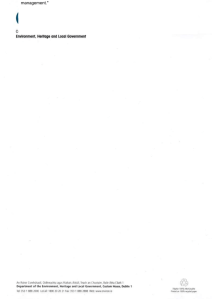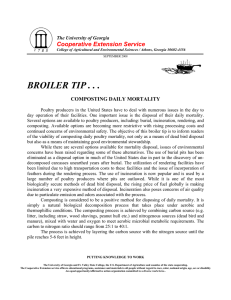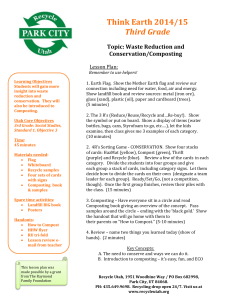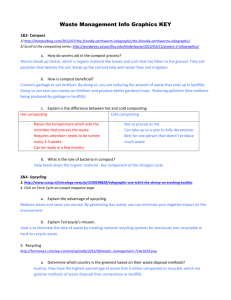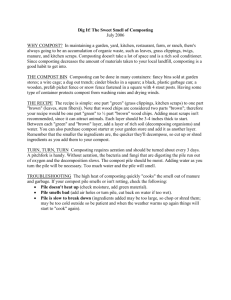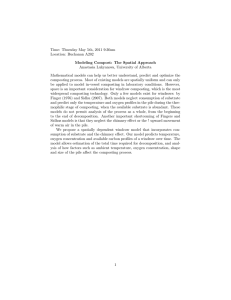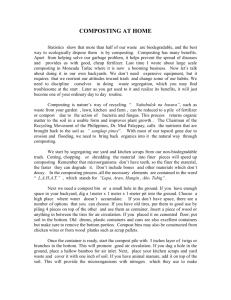Dead Bird Disposal Deep South Poultry Conference 2012 Incineration
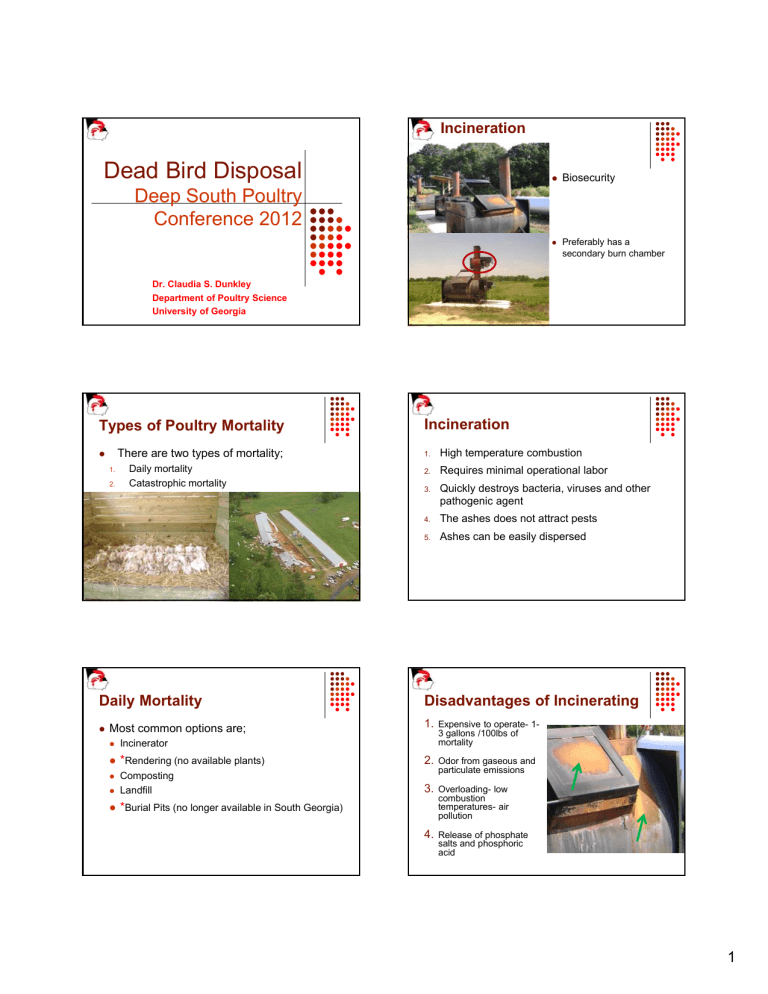
Dead Bird Disposal
Deep South Poultry
Conference 2012
Dr. Claudia S. Dunkley
Department of Poultry Science
University of Georgia
Types of Poultry Mortality
1.
2.
There are two types of mortality;
Daily mortality
Catastrophic mortality
Incineration
Biosecurity
Preferably has a secondary burn chamber
Incineration
1.
2.
3.
4.
5.
High temperature combustion
Requires minimal operational labor
Quickly destroys bacteria, viruses and other pathogenic agent
The ashes does not attract pests
Ashes can be easily dispersed
Daily Mortality
Most common options are;
Incinerator
* Rendering (no available plants)
Composting
Landfill
* Burial Pits (no longer available in South Georgia)
Disadvantages of Incinerating
1.
Expensive to operate- 1-
3 gallons /100lbs of mortality
2.
Odor from gaseous and particulate emissions
3.
Overloading- low combustion temperatures- air pollution
4.
Release of phosphate salts and phosphoric acid
1
Composting
Natural biological decomposition process;
takes place under aerobic (requiring oxygen) thermophilic (high temperature) conditions
Limitations of Landfill
Legality depends on the classification of the facility
Permission is needed ahead of time- not always a guaranteed
Transportation and tipping fees applies
Breeches of bio-security
Small county or municipal landfills are not usually equipped to handle large volumes of livestock during an emergency
Composting
Carcass composting offers several benefits:
1.
Reduced environmental pollution
2.
Generation of a valuable end-product
3.
Destruction of many pathogens
4.
Free from unpleasant odors
5.
Easy to handle
6.
Can be stored for a long time
7.
Relatively inexpensive
Catastrophic Mortality
Natural acts;
Tornadoes
Flood
Thunder storms
Disease outbreak
Agro-terror attacks
Producers should have a plan in place in the event of mass mortality!
Landfill
May be an option in some locations
It is considered a method of burial
Catastrophic Mortality
The cause of the mass mortality may determine the method of disposal.
Methods available for mass disposal;
1.
2.
Windrowing- a composting process a) b)
Incinerating
Pyre Burning
Air-curtain Incineration
3.
4.
Landfill
Burial
2
Windrowing
Proper siting is necessary to allow composting and to prevent nutrient runoff into surface waters
Can be done inside the poultry house/litter shed if repopulation time schedules allows
Windrowing
Cover open air piles with a water-repellant breathable covering such as a composting fleece
Windrowing
If an under roof site is not available, use a site that is well drained and out of the flood plain
Use a temporary ground liner to prevent leaching from the windrow
2. Incineration
1.
2.
Incineration techniques for catastrophic mortalities are;
Pyre or Open Air Burning
Air-curtain
Windrowing
Site for the windrow should be accessible to machinery and away from areas of running or standing water
Pyre or Open Air Burning
Dates back to biblical times but is still used
Carcasses are burnt in open fields or on combustible heaps
Generates relatively benign waste (ash) that does not attract pests
Foot and Mouth disease outbreak in the UK 2002
3
Disadvantages of Pyre/Open air Burning
1.
Fire hazard especially in windy areas
2.
Pollutes in the atmosphere
3.
It is labor and fuel intensive
4.
The most lengthy of all the incineration processes
5.
Negative public perception;
Water contamination from fuel used
Dioxins and polychlorinated biphenyl can cause soil and food pollution concerns
Air Curtain Incineration
Fitted with a fan and air manifold system
Fan blows a high velocity air curtain over and into the combustion chamber
Air Curtain Incineration
Uses elevated burn temperatures which improves and reduces;
1.
Retention and combustion of smoke
2.
Large particulates
3.
Odorous emissions
4.
6X faster than open air
Air Curtain Incineration
1.
Two types;
Large open topped refractory lined metal boxes
2.
Temporary trenches excavated in the ground
1 2
Air Curtain Incineration
Burns at a rate of 1 ton/hr (small unit) to 10 ton/hr (larger unit)
Mobile
Environmentally sound
Service available from companies that specialize in disaster clean-up and recovery
Limitations of Air-Curtain
Incineration
Fuel intensive process requiring both liquid fuel and wood
Trained operators are required
It can be a fire hazard
Virginia AI outbreak 2002
4
Landfill
The quantity of carcass that can be disposed of is relatively large
Used for carcass disposal in recent major disease outbreaks;
Virginia AI outbreak
(1984 and 2002)
UK FMD outbreak (2001)
California END outbreak
(2002)
Virginia AI outbreak 2002
Composting 101
A permit is required from the state vet prior to construction
Submit the following:
Owners name and address
Exact location
Size and type of poultry operation
Construction plans
Any existing disposal permits
Disadvantages of Landfills
1.
Landfill operators decides whether or not to accept carcass material
2.
Public perception of potential health risk usually a determining factor for the operator
3.
Land-filling carcasses is a means of containment rather than elimination
4.
Long-term management of the waste is needed
Location
Your compost facility should be located to meet environmental interest to;
Protect ground and surface water and reduce risk of disease spread
Prevent invasion of insects and scavenging animals
Maintain air quality
Maintain good neighbors relations
Disadvantages of Landfills
5.
Potential spread of disease agent during transportation
6.
Smaller county of municipal landfills may not be designed to handle large volumes of carcasses
7.
Producers should contact land-fill operators well in advance a catastrophe about disposal needs!
Cost Sharing
The National Resource
Conservation Service
(NRCS) has standard designs and cost-share programs for composters of various sizes.
5
The concepts of composting
To provide the microbes with an environment which encourages their growth;
1.
Balanced diet (a carbon source)
2.
Oxygen
3.
Water
Oxygen
Microbes involved in composting are aerobic
(oxygen requiring) organisms
Pile should be aerated when the temperature declines
The oxygen content of the pile is mainly affected by the amount of aeration
Carbon Source
Supplies the nutrients for the microbes
Dead bird
Poultry litter
Sawdust
Straw
Shavings
Paper
Rice hulls
Cotton gin trash
Peanut Hull
Moisture
Microbes thrive best in moist conditions
Moisture levels in the compost should be 40-60%
Too little water will prevent the microbes from reproducing to adequately high numbers
Too much water can cause the compost to become soggy and anaerobic
Excess moisture will result in;
A compost pile that does not heat up
Odors
Reduction in the oxygen content of the pile
Retardation of growth and activities of some of the microbes
Carbon Source
50% of original carbon source remains
Carbon to nitrogen ratio (C:N) range;25:1 to
40:1
Generates enough energy
Produces little odor during the process
The dead bird and litter also creates pores within the pile which allows oxygen to flow through
Phases of the Composting Process
The process takes place in two phases
1.
Primary phase marked by increased temperature and soft tissue decomposition and the softening of bones
2.
Secondary phase, the remaining materials (mainly bones) break down fully and the compost turn to a consistent dark brown to black soil or humus
6
Layering the Primary Bin
1.
Place an initial layer of 8-12 inches of fresh litter on the concrete
2.
3.
Add a thin layer of bulking material such as straw, peanut hulls or coarse shavings
(optional).
Add a layer of bird carcasses in a single layer.
The Primary Bin
Temperature should rise to
~ 140ºF within 5 days and remain there for at least 7-
21 days.
When the temperature falls below 130-120ºF you will need to turn the pile for a second heating phase.
You turn the pile by using a
“Bob Cat” or other similar equipment to transfer the compost material to the secondary bin.
One day after compiling compost
6.
7.
Layering the Primary Bin
Repeat steps 2-5 until it reaches a height of 5-6 feet.
The last layer will be a cap of 8-10 inches of litter. This will help to eliminate odors and prevent flies and scavengers from invading your compost pile.
Secondary Phase
Moisture is added to reheat the materials
The temperature should again rise to ~149 0 within days
Last for ~3weeks
The Primary Bin
When you have completed one primary bin you can move on the next down the line. The size and number of the bins depends on the equipment that you will use and the size of the farm.
Secondary Phase
The end of the secondary phase is marked by:
Internal temperature of 77-
86ºF
Reduction in bulk density of about 25%
Product color dark brown to black
Lack of unpleasant odor at turning
7
Keys to Success
The Keys to a successful composting process can be obtained by maintaining and monitoring the following:
Temperature
Time
Porosity
Aeration
Limitations of Composting
Requires proper management
Temperature must be monitored
Dr. Claudia Dunkley
Poultry Science Department cdunkley@uga.edu
www.poultry.uga.edu
8
